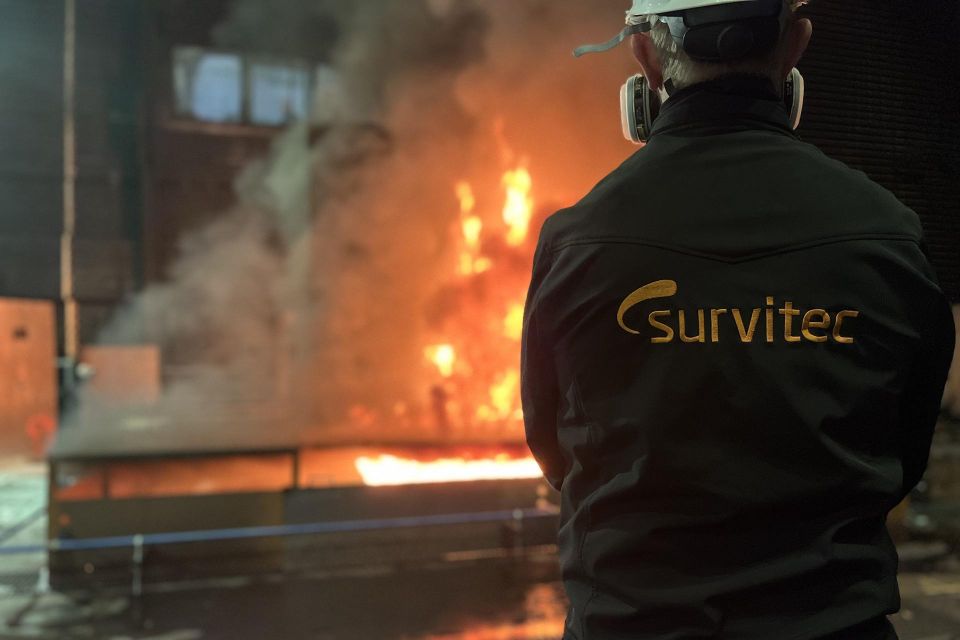Existing fire-fighting methods used to extinguish machinery space spray and pool fires on conventionally fuelled vessels are inadequate when dealing with methanol-based fires. Survitec says this after conducting a new fire safety study.
This follows extensive comparative fire tests on dual-fuel marine engines using diesel oil (DO) and methanol, carried out amid growing interest in methanol as an alternative marine fuel.
‘Our tests confirm that traditional water mist fire suppression mechanisms do not perform as expected on methanol pool fires and methanol spray fires. A completely different approach is required if these ships are to remain safe,’ says Michal Sadzynski, product manager water mist systems at Survitec.
Methanol is a methyl alcohol (CH3OH) that burns in a completely different way than hydrocarbon fuels and has a much lower flashpoint of 12°C (54°F). However, while there are established fire safety regulations and testing standards for diesel fuels, clear test protocols for alcohol-based fuels such as methanol and ethanol have yet to be developed.
Also read: Survitec redesigns fire system for crewless operation on board Yara Birkeland
Redesign of fixed fire-fighting systems
‘We believe this is a high-risk situation that needs immediate action,’ stresses Sadzynski. ‘Methanol fires are far more aggressive than fires involving traditional hydrocarbon fuels. Methanol fires have different physicochemical properties and so they cannot be extinguished as easily or with the same approach.’
The Survitec tests found that while water mist systems are highly effective in absorbing heat and displacing oxygen on diesel fires, they do not produce the same results on methanol fires.
‘We had to completely rethink nozzle placement, spacing and other factors to make water mist suppression effective on methanol. For instance, the range for nozzle installation height is much lower than that needed to put out a diesel fire,’ he says.
This finding indicates that if existing vessels are retrofitted to run on methanol, they would need to overhaul and redesign their fixed fire-fighting arrangement completely.
Bilge areas
For bilge areas, statutory rules formulated in IMO MSC.1/Circ.1621 establish a requirement for an approved alcohol-resistant foam system for ships running on methanol. For the first time, a fixed, low expansion foam system is mandatory under the rules when it comes to protecting machinery space bilges.
‘Our tests demonstrate that standard discharge devices do not properly extinguish methanol pool fires in the confined bilge space. It is crucial to deliver properly expanded foam on the methanol pool fire and this is not an easy task within such a narrow space where throw length is limited,’ explains Maciej Niescioruk, product manager foam systems at Survitec.
He adds: ‘MSC.1/Circ.1621 provides us with a starting guideline, but it is very general and therefore open to interpretation. Moreover, methanol compliance for Local Application Firefighting (LAFF) systems is not yet covered. As an industry, we need to come together and develop comprehensive and robust fire test standards and safety rules tailored to methanol’s unique properties.’
Also read: World’s largest inflatable lifeboat Seahaven wins technology award
Methanol-fuelled ship orders on the rise
The stark conclusion of the investigation arrives at a time of increasing orders for methanol-fuelled ships. The greener fuel is seen as a panacea to meeting the industry’s emissions abatement targets, and forecasts predict accelerated adoption rates.
Orders for methanol-fuelled newbuilds increased by nine per cent in the last twelve months, two per cent more than those for LNG-fuelled ships. Analysts suggest the methanol-fuelled fleet will account for 20 mGT by 2028.
‘We are seeing a significant uptake in orders for methanol-fuelled vessels, with 2023 being the breakout year for this alternative marine fuel. With more methanol-powered ships being built every year, the industry must act now to prevent dangerous gaps in fire safety,’ says Niescioruk. ‘We encourage all stakeholders to come together to address methanol’s unique fire risks and create clear standards, new testing protocols and updated safety rules for methanol.’
Picture: Tests confirm that traditional water mist fire suppression mechanisms do not perform as expected on methanol pool fires.
Also read: ONE orders twelve methanol dual-fuel container ships








